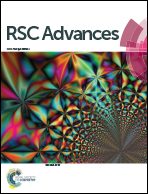Switching selectivity between Pb2+ and Hg2+ ions through variation of substituents at xanthene end; ‘turn-on’ signalling responses by FRET modulation†
Abstract
Few rhodamine based probes (L1–L4) that consist of a similar 2-(aminoethyl)-pyridine unit at their carboxamide end but vary with substituents attached to the N-atom at their xanthene end were synthesized. Rhodamine G based probes L1–L3 have shown preferential chromogenic and fluorogenic ‘turn-on’ spectral responses in the presence of Pb2+ ions, where one of the two ethyl substituted secondary amino groups attached to the xanthene core either remains un-substituted (as in L1) or is functionalized with a bulky aromatic group (as in L2) or a long alkyl chain (as in L3). On the contrary, the L4 probe that incorporates two ethyl-substituents at both N-atoms attached to the xanthene core has selectively exhibited a dual mode spectral amplification in the presence of Hg2+ ions. The reversible selective dual mode signalling pattern of bifluorophoric L2 in the presence of Pb2+ ions is because of the perturbation of the combined PET (photo-induced electron transfer) inhibition and FRET (fluorescence resonance energy transfer) initiation processes. The observed ratiometric signalling pattern enabled it to detect Pb2+ ions at a low concentration level, even in living organisms such as E. coli. The altered selectivity in the signalling pattern infers a modulated stereo-electronic environment for metal ion coordination, which in turn is caused by induced amine rigidity at the xanthene end.


 Please wait while we load your content...
Please wait while we load your content...